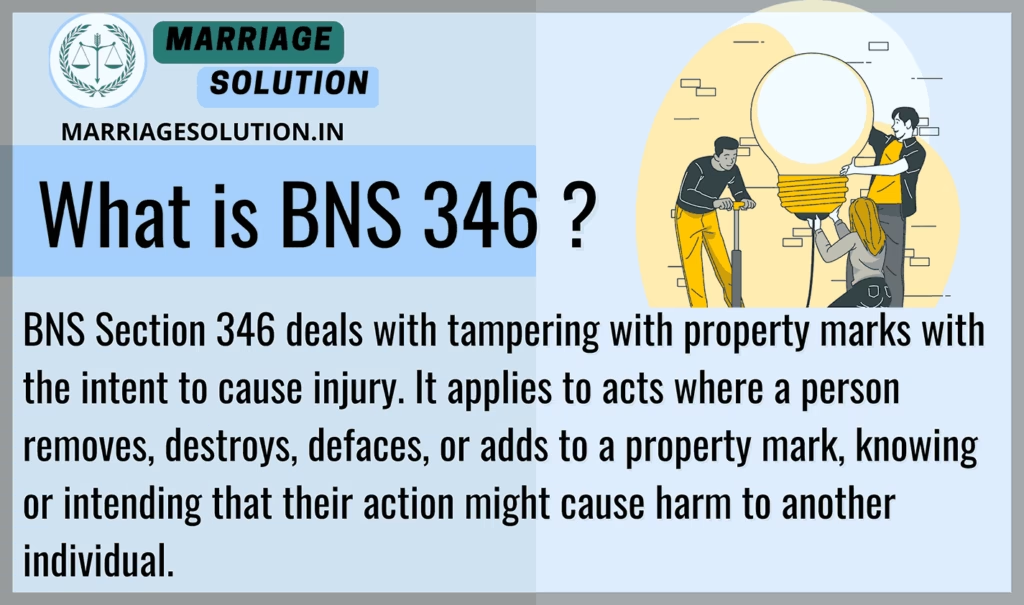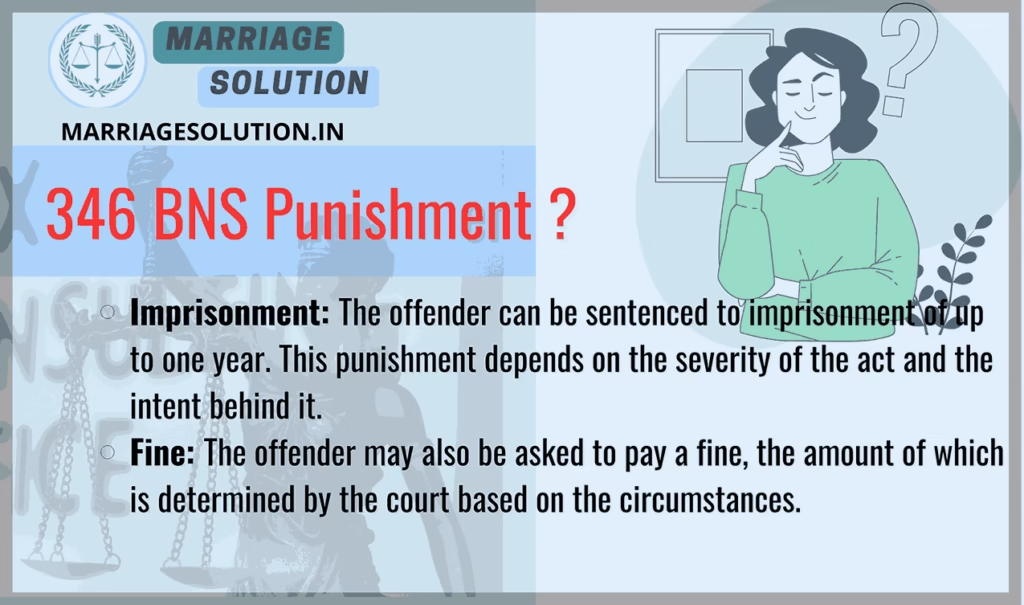Introduction of 346 BNS
346 BNS of the Bharatiya Nyaya Sanhita deals with the offense of tampering with property marks such as removing, altering, defacing, or adding to them with the intent or knowledge that such acts may cause injury to another person. Property marks are vital to signify ownership and authenticity of movable property, and tampering with them can lead to fraud, financial loss, or even safety risks. This law ensures accountability by punishing those who engage in dishonest practices involving property marks.
The Bharatiya Nyaya Sanhita (BNS) Section 346 replaces the old Indian Penal Code (IPC) Section 489.
What is BNS Section 346 ?
BNS Section 346 deals with tampering with property marks with the intent to cause injury. It applies to acts where a person removes, destroys, defaces, or adds to a property mark, knowing or intending that their action might cause harm to another individual.

Under Section 346 of the bns act 2023
Whoever tampers with any property mark—by removing, defacing, altering, or adding to it—intending or knowing it is likely to cause injury to another person, shall be punished with imprisonment up to one year, or with fine, or with both.
1. Meaning of Tampering with Property Marks
- Property mark → A sign, seal, stamp, or label used to identify ownership or authenticity of movable property.
- Tampering → Any act of removing, altering, defacing, or adding to the property mark.
- Example → Scratching off a company’s seal from machinery or replacing the genuine logo on goods with a fake one.
2. Essential Ingredient – Intention to Cause Injury
- The act must be done intentionally or with knowledge that it may cause injury.
- Injury here includes:
- Financial loss
- Damage to reputation
- Misleading consumers
- Risk to health or safety
- Example → Removing a safety certification mark from a medical device to mislead buyers.
3. Punishment under BNS Section 346
- Imprisonment → Up to 1 year
- Fine → Amount decided by the Court
- Both → Court may impose imprisonment and fine together in serious cases
This ensures proportionate punishment depending on the impact of tampering.
4. Nature of the Offense
- Bailable → Accused can obtain bail as a matter of right.
- Non-Cognizable → Police cannot arrest or investigate without magistrate’s permission.
- Non-Compoundable → Cannot be privately settled between parties.
- Trial by → Any Magistrate.
5. Examples of BNS Section 346 in Action
- Example 1 – Business Fraud:
A trader removes the property mark of a competitor’s goods and replaces it with his own to sell them. → Punishable under Section 346. - Example 2 – Safety Risk:
An employee erases the quality assurance seal from electrical equipment, knowing it may lead to accidents. → Offense under Section 346. - Example 3 – Innocent Case (Not Offense):
A warehouse worker accidentally damages a property label without intention to cause harm. → Not punishable under this section.
6. Importance of Section 346
- Protects ownership rights and prevents fraudulent misrepresentation.
- Ensures public safety, especially in industries like food, medicine, and machinery.
- Maintains trust in property marks as reliable identifiers of authenticity.
Section 346 BNS Overview
Under BNS Section 346, “tampering with property marks” refers to any act where a person intentionally modifies or damages property markings to mislead, deceive, or harm others. This includes actions like removal, destruction, or alteration of marks on property such as labels, seals, or stamps, knowing that such an act could result in injury to someone.
10 Key Points : BNS 346
1. Definition of Property Marks
Property marks are symbols, signs, or stamps used to indicate ownership, authenticity, or identity of an object or property. For example, a company seal on a product ensures it is genuine. Tampering with these marks disrupts trust and may harm individuals or businesses that rely on these indicators for safety or legal identification.
2. Acts Covered Under BNS Section 346
This section applies to acts such as removing, destroying, defacing, or adding to property marks. For example:
- Removing a seal on a product to replace it with a counterfeit one.
- Defacing an official logo to make it unrecognizable.
- Adding false markings to deceive others about the ownership of property.
3. Intent to Cause Injury
A critical aspect of BNS Section 346 is the intention behind the tampering. The offender must intend or know that their actions could harm someone. For example:
- A person removes a security label from a medicine box, knowing it could mislead the consumer, causing health risks.
4. Punishment Under BNS Section 346
The law prescribes the following punishments:
- Imprisonment for up to one year.
- Fine (amount decided by the court based on circumstances).
- Both imprisonment and fine in severe cases. For instance, if tampering leads to significant financial or physical harm, the offender may receive a harsher penalty.
5. Classification of the Offense
The offense is classified as:
- Non-Cognizable: The police cannot arrest or investigate the accused without prior permission from a magistrate.
- Bailable: The accused has the right to apply for bail.
- Non-Compoundable: The case cannot be settled privately between the parties and must go through the court.
6. Examples of BNS Section 346 Application
- Example 1: A person defaces a property mark on an antique sculpture and sells it as a different brand. This misleads buyers and causes financial injury.
- Example 2: An employee removes a safety certification mark from a machine, making it appear uncertified and damaging the company’s reputation.
7. Role of Knowledge in the Offense
Even if there was no direct intent to harm, the offender is still liable if they knew their actions were likely to cause injury. For example:
- Removing a safety label from electrical equipment, knowing it might lead to misuse and harm.
8. Importance of Property Marks
Property marks are vital for:
- Establishing ownership of items.
- Ensuring authenticity of goods and services.
- Preventing fraud in legal or business transactions. Tampering disrupts this trust and creates legal or financial harm.
9. Why BNS Section 346 is Necessary
Without this law:
- Businesses could face massive losses due to counterfeit goods.
- Individuals could be misled into buying fake or unsafe products.
- Trust in property marks would diminish, harming the economy and public safety.
10. Jurisdiction and Trial Process
- The case is triable by any magistrate.
- Magistrates can impose the specified punishments and decide fines based on the severity of the tampering. This accessibility ensures quick legal recourse for victims.
Examples of BNS Section 346
- Example 1:
A person removes the manufacturer’s label from a product and replaces it with a counterfeit label to mislead buyers. This act is punishable under BNS Section 346 because it defaces the property mark with the intent to deceive. - Example 2:
An individual scratches off a seal from machinery owned by a company to claim it as their own. This removal of the property mark, knowing it could harm the original owner, makes the act a punishable offense.
BNS 346 Punishment
- Imprisonment:
The offender can be sentenced to imprisonment of up to one year. This punishment depends on the severity of the act and the intent behind it. For example, if someone tampers with property marks leading to financial or physical harm, the punishment might lean towards imprisonment to ensure accountability. - Fine:
The offender may also be asked to pay a fine, the amount of which is determined by the court based on the circumstances. In some cases, the court may impose both imprisonment and a fine, ensuring fair punishment for the damage caused.

BNS 346 bailable or not ?
BNS Section 346 is a bailable offense. This means the accused can seek bail as a matter of right. The police cannot deny bail, and the court typically grants it unless there are exceptional circumstances.
Comparison: BNS Section 346 vs IPC Section 489
| Section | Offense | Punishment | Bailable / Non-Bailable | Cognizable / Non-Cognizable | Trial By |
|---|---|---|---|---|---|
| BNS Section 346 | Tampering with any property mark by removing, defacing, altering, or adding to it, intending or knowing it is likely to cause injury to another person. | Imprisonment up to 1 year, or fine, or both. | Bailable | Non-cognizable | Any Magistrate |
| IPC Section 489 (Old) | Tampering with property marks with intent to cause injury — removing, altering, defacing, or adding to property marks of another person’s goods or property. | Imprisonment up to 1 year, or fine, or both. | Bailable | Non-cognizable | Any Magistrate |
BNS Section 346 FAQs
What is the offense under BNS Section 346?
The offense under BNS Section 346 involves removing, destroying, defacing, or altering a property mark with the intention or knowledge that such actions may cause harm or injury to another person. It specifically targets acts that aim to mislead or damage the interests of the rightful owner.
What is the punishment under BNS Section 346?
The punishment for tampering with property marks under BNS Section 346 includes imprisonment of up to one year, a fine, or both. The exact punishment depends on the severity of the offense and the intent behind the act.
Is BNS Section 346 a bailable offense?
Yes, BNS Section 346 is a bailable offense. This means the accused has the right to obtain bail, and the court usually grants it unless there are extraordinary circumstances warranting denial.
Is BNS Section 346 cognizable or non-cognizable?
BNS Section 346 is a non-cognizable offense, meaning the police cannot arrest the accused or start an investigation without prior approval from a magistrate.
What kind of property is covered under BNS Section 346?
BNS Section 346 applies to all types of property that have identifiable marks, such as seals, labels, or stamps, which are meant to indicate ownership, authenticity, or legal identification. Tampering with any of these marks falls under this section.
Who tries cases under BNS Section 346?
Cases under BNS Section 346 are tried by any magistrate. This means the trial can be conducted by judicial officers with the authority to handle such non-cognizable and bailable offenses.
Conclusion
The introduction of BNS Section 346 strengthens India’s legal framework for protecting ownership and authenticity of movable property. By penalizing tampering with property marks, the law prevents fraud, ensures fair trade, and safeguards consumers from potential harm. While BNS Section 345 punishes using false property marks, BNS Section 346 specifically targets tampering with genuine marks. Together, these provisions maintain trust in commercial practices and protect both businesses and individuals from deception.
Need Legal Support?
If you are dealing with court cases, marriage problems, or any other legal issue, our team at Marriage Solution – Lawyer Help is here for you. Simply fill out our quick online enquiry form, and we’ll connect you with the right legal expert to support your needs.
Finished with BNS 346 ? Continue exploring the next provisions of the Bharatiya Nyaya Sanhita (BNS), 2023. Each section includes explanations, examples, and plain-language breakdowns for easy understanding.
- 347 BNS : Counterfeiting a property mark.
- https://marriagesolution.in/bns_section/347-bns/
- 348 BNS : Making or possession of any instrument for counterfeiting a property mark.
- https://marriagesolution.in/bns_section/348-bns/
- 349 BNS : Selling goods marked with a counterfeit property mark .
- https://marriagesolution.in/bns_section/349-bns/
- 350 BNS : Making a false mark upon any receptacle containing goods .
- https://marriagesolution.in/bns_section/350-bns/
Chapter XIX – Of Criminal Intimidation, Insult, Annoyance, Defamation, Etc.
- 351 BNS : Criminal intimidation .
- https://marriagesolution.in/bns_section/351-bns/
Full IPC Section List: https://marriagesolution.in/ipc-section-list
All Indian Law & Blogs: https://marriagesolution.in/indian-law/
Full BNSS Section List: https://marriagesolution.in/bnss_section-list
